Hello. I go into the Noh play part. Therefore
I want to investigates about a Noh
play.
|
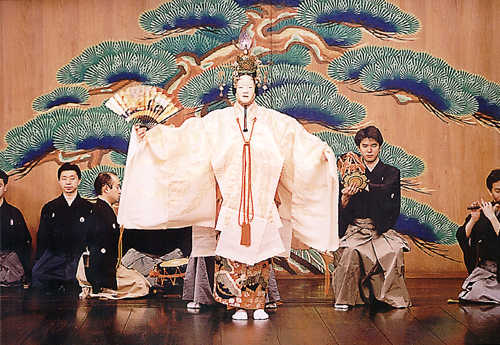 |
History
Before completion
If the origin of a Noh play is followed, it
will go back till the long distance Nara
period. Private sector entertainments called
"Sangaku"were in one of the entertainments across
which it has gone from a continent
those
days. When the Heian period came and
this
was abandoned, it distributed in various
places and the players made the group,
and
the art was performed, or many made
a provincial
tour around every place by the festival
etc.
in response to protection of a big
temple
company, and continued the art.The
name of
"Sangaku" also comes to be
called
"Sarugaku" to these days in the style of Japan,
and mimicry also with the gradually
humorous
contents of an art serves as a subject.
This
transforms itself from mere mimicry
with
a time, and develops into development
and
next "Kyogen" as a words play of the laughter which
catches and satirizes various social
trends. |
The Noh play of a completion term
If it becomes at the time of the Northern and Southern Dynasties while many seats of "Dengaku" and "Sarugaku" compete for an art, the Yamato sarugaku and the Omi sarugaku express power.The Yamato sarugaku bore the
expert "Kan'ami" representing the second half of the
14th century especially.Kan'ami got general Yoshimitsu Ashikaga's support, took in the element of songs,
such as "Dengaku" and the "Omi sarugaku", or dancing to the strong characteristic
style of the mimicry subject which
is the
tradition of the "Yamato sarugaku", raised to it in arts, and also also
performed reform in respect of music,
and
greatly urged development. "Zeami" established the art of "Noh play " which inherits the achievement of
this father and Kan'ami and is transmitted till today.The entertainments
itself have already built the steadfast
status
in this time, and much authors will
induce
many works and they might not only
become
the entertainments representing the
Muromachi
period, but will continue having the
stage
life which breathes continuously even
now. |
The Noh play of the Age of Civil Wars
to theMomoyama term
The weakened government after the Onin
War
and a decline of a temple company dealt
a
big
blow to Noh play.Although the way out was
slightly found out to the general public's
support, most of "Dengaku" and the "Omi
sarugaku" disappeared and the Noh players who
depend for an owner inthe second half
of
the
16th century, and godown to a districtoccurred
one afteranother.Especially, it was
known
that
Nobunaga Oda was friendly to the Noh play, and
Hideyoshi Toyotomi was a still more
enthusiastic lover.The style of a magnificent
Noh stage was established against the
background of prosperity of this time
and
the
gorgeous Momoyama culture.Moreover, the
dress also became luxurious much more.The
expert appeared in great numbers also
to
the
author of a Noh mask, and the kind
of Noh
mask used now came out fully mostly.lso
production and words This time when
maintenance progressed and experts
occurred
one after another also to kyogen was
also
a big
turning point while being the revival
term
of a
Noh play. |
The Noh play of the Edo period
After Hideyoshi died, Ieyasu Tokugawa
who became a generalissimo shogun also
followed Hideyoshi's system, gave the player
dividend rice etc., and protected the Noh play.
A government and many hans While it was the
guardian of a Noh play, it was also a severe
management supervisor.As a result of
requiring
exact succession of training of arts,
and
tradition,
ability increased graveness gradually,
the
business
time of one music also became long,
and it
changed with the severe notification
taken
out frequently to the severe entertainments
which exhaust energy and physical strength.
A modern Noh play
Many of Noh players who lost the guardian
by the Meiji Restoration give up their business.
It was obliged to change of employment,
and there was also a severed style.
However,
the Noh play fetched the breath by the
government which keenly realized the
necessity
for national tradition art in response
to
the
influence of a foreign art protection
policy,
support of the Imperial Household,
the nobility, and a new zaibatsu, etc. |
About the stage
The stage for Noh plays consists of
"Main
stage" and "Hashigakari",
and "Kagaminoma" There is
no decoration
beyond the necessity of the Shiraki
structure
of a cypress. A jar is put into the
bottom
of the floor and its sound is important
to
the performance.
About "Main stage"
The stage is the place about 6m around with
a roof. When a figure on the No.1 explains,
it is the square portion where seven persons
are sitting down.
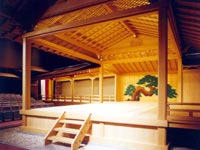
About "Hashigakari"
In the photograph at the NO.1, the portion
of the bridge in left-hand side will be said
"Hashigakari." Although there is
no strict rule, about 12m - 15m is a standard.
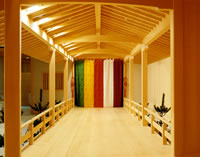
About "Kagaminoma"
"Kagaminoma" is an extension of
a "Hashigakari". It is a room on
the other side of the curtain of the bridge
located on the left-hand side in the No.2
photograph. It is usually not visible. Since
a big mirror is attached to the wall, it
is called "Kagaminoma" (mirror
place). The performer wearing a gown enters
before the commencement of the performance,
and builds feeling toward the mirror. The
Noh mask placed on the stand of white wood
in front of the mirror is respectfully picked
up with both hands, and placed on the performer's
face. In this way, he is disguised as a hero.
That is, "Kagaminoma" can be called
the important place which a performer disguises
himself, namely, carries out incarnation.
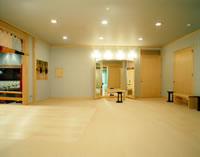 |

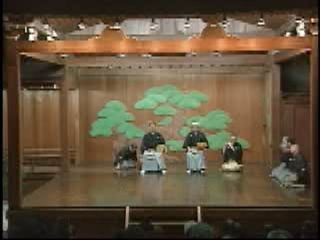

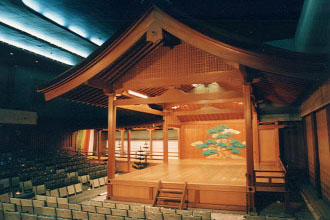
|
The view of a Noh play
You do not need to dress or prepare
formally.
If you are interested, please come
by all
means. You can surely be satisfied.
It will
become a precious memory. Conversely,
you
will get the feeling of "being
looked
at and repentant." Even if you
know
nothing about Noh, you do not have
anxious.
I want you to see by your sensitivity
first
rather than come with any preconceived
ideas.
The program of a Noh play is not distinguished
for beginners and experts. However,
if I
can advise one thing, the specific
gravity
of the theater's nature will say that
it
is high and begins to see from the
program
dealing with a prominent historical
fact
and a prominent tale, and this will
affect
you. Dress is casual. You may come
in sneakers,
jeans, or a polo shirt. However, please
don't
wear revealing dress and sandals or
shorts.
As for clapping, I will think that
what is
necessary is just to express your gentle
feeling. In order to enjoy the reverberation
of the stage, there are some spectators
who
do not dare applaud. A Noh play has
a different
wavelength of various sensitivities
for every
program. You do not necessarily have
the
same experience each time. By going
to see
a Noh play, a wonderful encounter is
surely
waiting for you. |
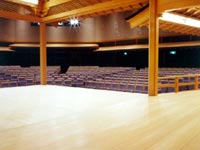
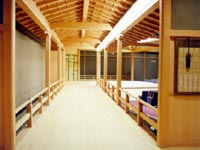 |